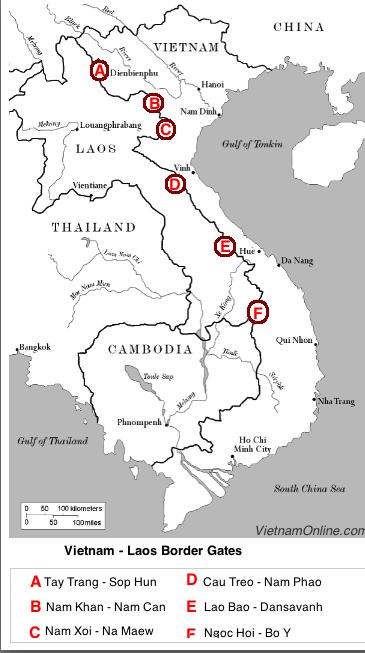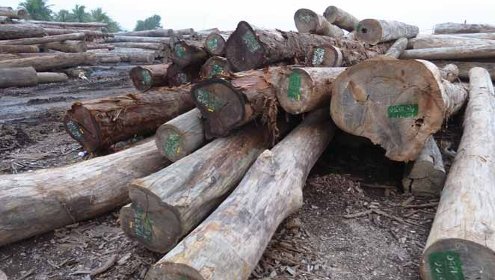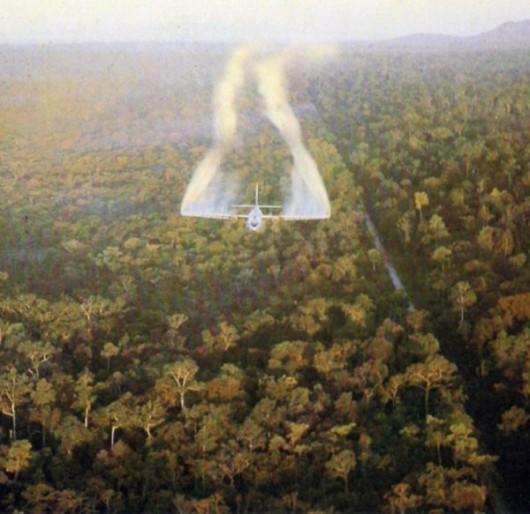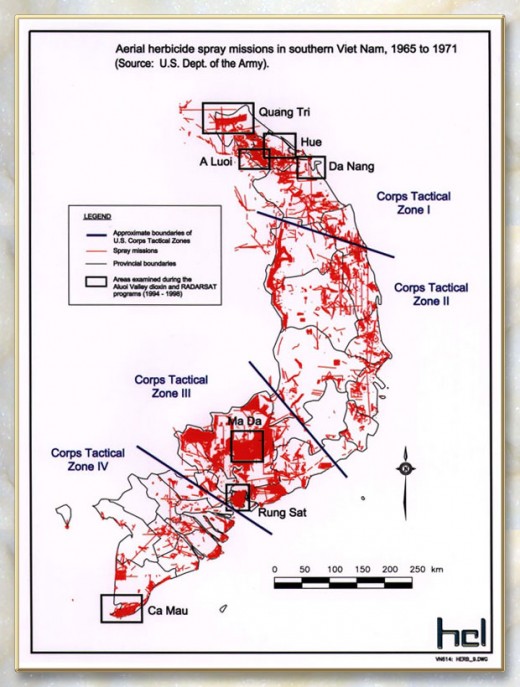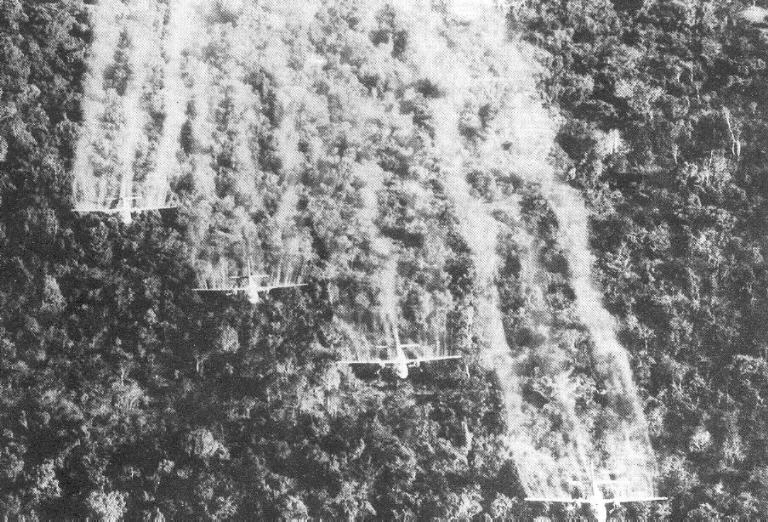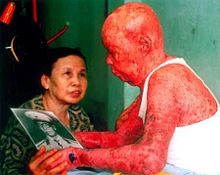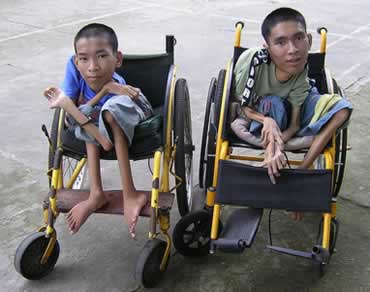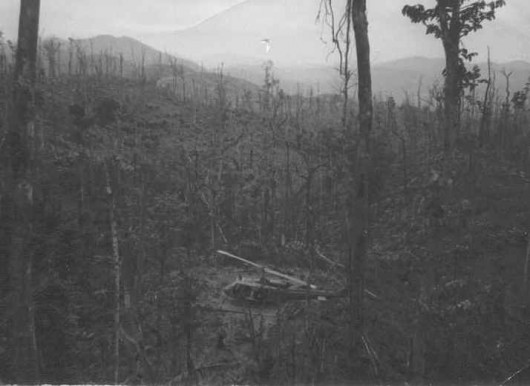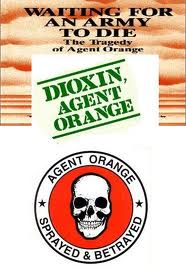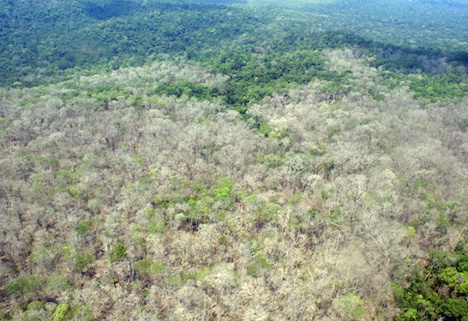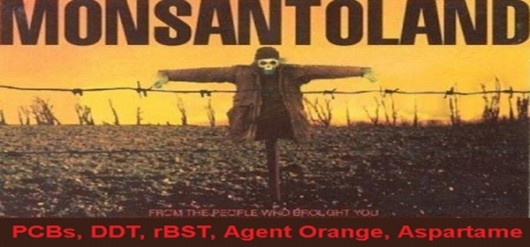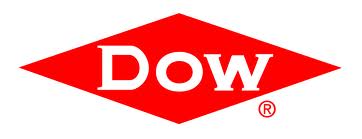Vietnamese Army named as timber smuggler
Tuesday, February 21st, 2012.
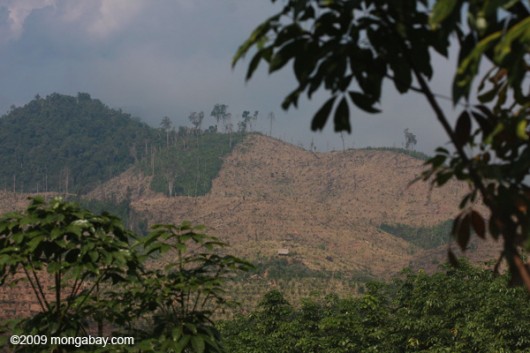 Forests in Laos have declined steadily in recent decades,
falling from 64% cover in 1960 to 41% in 2005.
Primary forests now cover less than 10 % of the country according to U.N. data.
(Source: Mongabay, ^http://news.mongabay.com/2011/0622-laos_crackdown.html)
Forests in Laos have declined steadily in recent decades,
falling from 64% cover in 1960 to 41% in 2005.
Primary forests now cover less than 10 % of the country according to U.N. data.
(Source: Mongabay, ^http://news.mongabay.com/2011/0622-laos_crackdown.html)
.
BANGKOK: A new report released today (20110728) exposes the pivotal role played by the Vietnamese military in a multi-million dollar operation which is smuggling threatened timber over the border from the shrinking forests of neighbouring Laos.
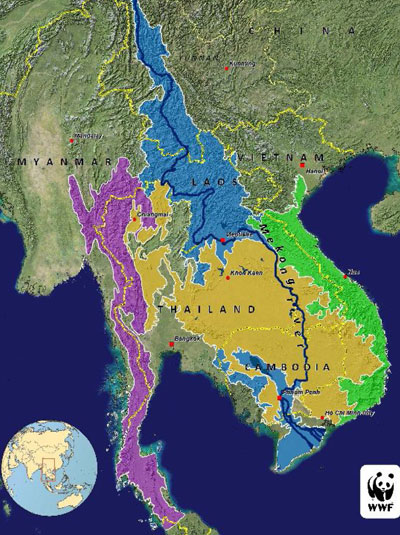 Greater Mekong Region
Greater Mekong Region
.
Laos has some of the Mekong region’s last intact tropical forests, but the London-based Environmental Investigation Agency (EIA) report Crossroads: The Illicit Timber Trade Between Laos and Vietnam reveals its export ban on raw timber is routinely flouted on a massive scale to feed the ravenous timber processing industries of Vietnam, China and Thailand.
During undercover operations in 2010 and 2011, EIA agents posing as timber buyers tracked a trail of corruption and inadequate enforcement back from the busy furniture factories and ports of Vietnam to its border with Laos and beyond.
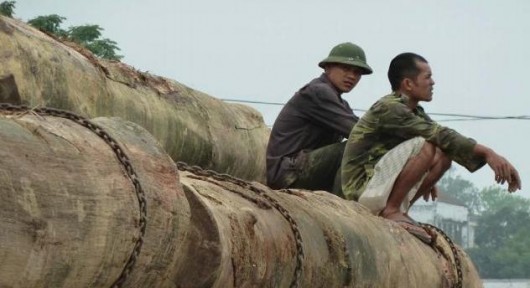 The forests of Laos support the livelihoods of millions of rural and indigenous people but are seriously threatened by over-exploitation; such is the volume of illegal timber flowing through Laos’ porous borders that its furniture manufacturing industry is finding it cannot supply orders due to a lack of raw materials.
The forests of Laos support the livelihoods of millions of rural and indigenous people but are seriously threatened by over-exploitation; such is the volume of illegal timber flowing through Laos’ porous borders that its furniture manufacturing industry is finding it cannot supply orders due to a lack of raw materials.
Through investment in logging, plantations and hydropower projects, Vietnamese firms have appropriated large swathes of Lao forests, yet the only winners in Laos are corrupt Government officials and well-connected businessmen. Meanwhile, Vietnamese logging companies and furniture factories are booming on the back of the illegal trade, exporting billions of dollars worth of finished wood products to the major markets of the USA and European Union.
And EIA’s investigations revealed that one of the biggest loggers in Laos is a company owned by the Vietnamese military. Investigators first encountered the Vietnamese Company of Economic Cooperation (COECCO) in October 2010 during a visit to Qui Nhon port, documenting huge piles of logs bearing green paint marks and tagged with yellow labels bearing a Vietnamese name which translated into Company of Economic Cooperation – Ministry of Defence (or COECCO). A port worker said 95 per cent of the logs had come from
Laos and most were owned by the Vietnamese military; specifically Military Zone 4.
Similarly marked logs were observed in a huge storage area between the two formal checkpoints at the Bo Y border crossing (‘F‘ on map below) and EIA was eventually able to confirm that most of them had come from logging operations linked to the construction of a nearby hydropower dam.
To uncover more details of the company’s operations, EIA investigators travelled to COECCO’s headquarters in Vinh City, Vietnam, in May 2011 and learnt COECCO has been in the timber trade and logging business in Laos for more than 20 years, that it sources most of its logs from Lao dam clearance sites and that it is one of a handful of companies permitted to carry out logging in these areas.
A well-connected Lao company is also making a fortune trading logs to Vietnam; the Phonesack Group, the boss of which is connected with the Lao Government, prefers to send logs across the border while its own wood processing struggles to get supplies of raw material.
EIA Head of Forest Campaign Faith Doherty said:
“EIA first exposed the illicit log trade between Laos and Vietnam in 2008, and our latest investigations reveal that sadly nothing has changed.
“The governments of Vietnam and Laos urgently need to work together to stem the flow of logs and curb the over-exploitation of Laos’ precious forests before it’s too late, and the Vietnamese military must be excluded from logging operations in Laos. “With a new Timber Regulation coming into force within European markets in 2013, both Vietnam and Laos have a lot at stake and urgently need to work with the European Union.”
.
Urgent Call to Action – by EIA
.
1. THE GOVERNMENT OF LAOS SHOULD:
- Enforce its log export ban
- Publish details of all logging quotas and the selection process
- Clarify rules for converting forest land for plantations
.
2. THE GOVERNMENT OF VIETNAM SHOULD:
- Respect the policies of the Lao Government by blocking log imports from the country
- Hold bilateral talks with the Government of Laos over illicit wood trade between the two countries
- Work with Vietnamese wood industry associations to exclude Lao logs from its supply chain
- Exclude military businesses from carrying out logging operations in Laos
.
3. THE EUROPEAN UNION SHOULD:
- Ensure that any Voluntary Partnership Agreement (VPA) discussions with Vietnam and Laos address the issue of log trade between the two countries
- Ensure that VPA talks include the full range of stakeholders
- Promote forest governance lessons from FLEGT (Forest Law Enforcement, Governance and Trade) into the development of REDD+ (Reducing Emissions from Deforestation and Forest Degradation) , specifically in terms of displaced deforestation
.
4. COMPANIES AND CONSUMERS SHOULD:
- Obtain proof that wood products sourced from Vietnam are not derived from logs imported from Laos
Copies of the full Crossroads report, stills and footage are available on request from Environmental Investigation Agency (EIA) Press Officer Paul Newman at paulnewman@eia-international.org, or or Faith Doherty at faithdoherty@eia-international.org.
.
Illegal logging and the associated trade in stolen timber
.
[Source: ‘Transnational Organised Crime in South East Asia: Threat Assessment‘, article in newsletter ‘NTS Alert’, July 2010 (Issue 1), published by the Centre for Non-traditional Security Studies (NTS), within the S. Rajaratnam School of International Studies (RSIS), Graduate School of Nanyang Technological University, Singapore, ^http://www.rsis.edu.sg/nts/HTML-Newsletter/alert/NTS-alert-jul-1001.html] .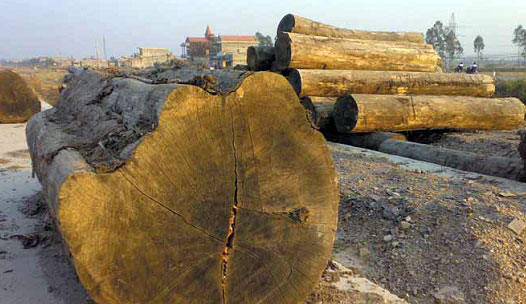 Yellow balau log from Lao Peoples Democratic Republic, awaiting transportation.
Yellow balau log from Lao Peoples Democratic Republic, awaiting transportation.(Photo : Environmental Investigation Agency, 2008)
.
Illegal logging occurs when timber is harvested, transported, processed, bought, or sold in violation or circumvention of national or sub-national laws (Miller et al., 2006). Between 8 and 10 per cent of global wood products stems from illegal logging, with annual global market value of losses estimated at over USD 10 billion (United Nations Office on Drugs and Crime – UNODC, June 2010). Southeast Asia is a major supplier of illicit timber with an estimated annual turnover of USD 3.5 billion. As much as 40 per cent of wood-based products imported into the EU in 2008 and half of China’s imports in 2007 (worth USD 900 million) originated from illegal logging.
Indonesia remains the country most heavily affected by illegal logging. The country possesses 123 million ha of forest (10 per cent of global forest cover) including the third largest tropical rainforest. As much as 80 per cent of timber logged in Indonesia is suspected to be illegally sourced with annual losses in government revenue estimated at USD 2 billion (Human Rights Watch, 2009). The Indonesian Ministry of Forestry estimates that in recent years, the country lost between 1.6 and 2.8 million ha of forest annually (between 3 and 5 ha a minute) to illegal logging and land conversion (UNODC, June 2010).
.
Imported Rainforest Timbers to Australia
[Source: ‘The Good Wood Guide: A Residents Guide to Purchasing Environmentally Friendly Timber’, Waverley Council, NSW, ^http://www.wettropics.gov.au/st/rainforest_explorer/Resources/Documents/8to9/GoodWoodGuide.pdf].
About 13% of Australia’s sawn timber is sourced from tropical forests. We also import tropical rainforest timber items such as veneers, plywoods and picture mouldings. The majority of these timber products are sourced from unsustainably logged forests and could be replaced by sustainable locally grown alternatives.
Logging tropical rainforests causes the extinction of hundreds of plant and animal species each year in addition to loss of the home of many indigenous tribal peoples. In South East Asian rainforests the rate of clearing is five million hectares per year. Once an intact rainforest has been destroyed, it cannot be replaced for thousands of years.
Ed: A rainforest is not a ‘renewable resource’. Rainforest timber is driving extinctions.
.
Commonly Imported South East Asian Rainforest Timbers to Avoid
.
- Meranti
- Merbau
- Ramin
- Pacific Maple
- Philippine Mahogany (Calantas)
- Keruing (also known as Naytoh, Narra and Kapur)
- Teak
- Jelutong
- Motoa (also known as Merawan, Batu)
- Balau
.
Old-Growth Forests
.
‘Old-growth forests are native forests which have had no recent disturbance by humans and regenerate naturally over hundreds of years. Like rainforest, old growth forests provide vital habitats for many species of flora and fauna. These forests are becoming increasingly rare both overseas and in Australia. Consequently we recommend that you avoid timbers sourced from old growth forests.’
Chea Sa Timber wholesales SE Asian rainforest timbers
…’We are a well established trading company situated in Malaysia. We have been in this industry since year 1995 and have earned superb reputation in our business circle. We offer a large variety of Tropical sawn timber. We have excellent sources and reliable network to fulfill both local and international market. ‘Currently, our overseas customers including Singapore, Hong Kong, China, Japan & etc. We intend to further expand our business to new markets abroad and looking for long term business partners worldwide.
Products
We specialize in following sawn timber, size in accordance to customer’s requirement:
- Finger Jointed Wood (Meranti, Durian, Sesendok)
- Meranti (Light Red/Dark Red)
- Kapur
- Kempas
- Keruing
- Merbau
- Merbatu
- KSK (Kembang Semangkok, or ‘Samrong’)
- Yellow Balau (Selangan Batu) & etc
.
[Source: ^http://www.cheasatimber.com/index.html]
.
‘Serano Timber’ in Dandenong Victoria retails Yellow Belau’
.
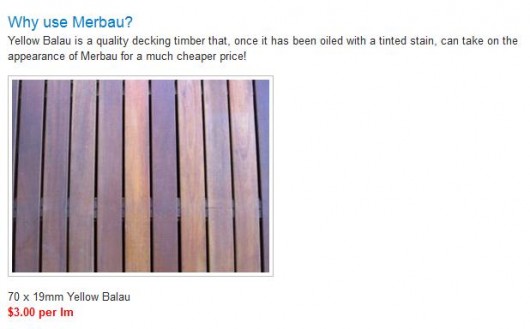
 Source: ^http://www.seranotimber.com.au/yellow-balau.html
Source: ^http://www.seranotimber.com.au/yellow-balau.html
.
Further Reading:
.
[1] FLEGT (Forest Law Enforcement, Governance and Trade), ^http://www.euflegt.efi.int/portal/ ‘The Forest Law Enforcement, Governance and Trade (FLEGT) Action Plan sets out a range of measures available to the European Union and its Member States to tackle illegal logging in the world’s forests. Use the menu on the left to find more information about the FLEGT programme.’.
[2] UN-REDD (Reducing Emissions from Deforestation and Forest Degradation), ^http://www.un-redd.org/ ‘The UN-REDD Programme is the United Nations Collaborative initiative on Reducing Emissions from Deforestation and forest Degradation (REDD) in developing countries. The Programme was launched in September 2008 to assist developing countries prepare and implement national REDD+ strategies, and builds on the convening power and expertise of the Food and Agriculture Organization of the United Nations (FAO), the United Nations Development Programme (UNDP) and the United Nations Environment Programme (UNEP).’.
[3] Illegal Logging (UK-based) website, ^http://www.illegal-logging.info/index.php , ‘The purpose of this site is to provide information on the key issues in the debate around illegal logging and the trade in illegal timber, via news stories and key documents, as well as details of relevant events, and links to other relevant websites.’